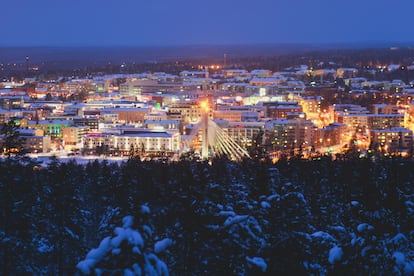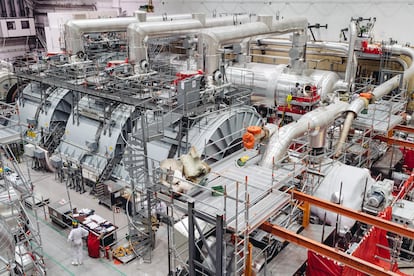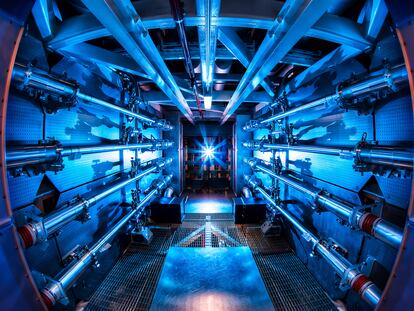More stairs, less sauna: Finland’s efforts to avoid blackouts
While citizens reduce energy consumption, cities like Rovaniemi are bracing for a possible extreme cold wave that could cause the electricity grid to collapse


In the Finnish city of Rovaniemi, Christmas does not end at New Year’s. The ubiquitous references to Santa Claus, the snow, the fir trees, the street lighting and the few hours of sunshine last for several more weeks after that. After two very complicated winters due to the Covid pandemic, local authorities this year welcomed back the tens of thousands of tourists who descended on the capital of Finnish Lapland in December, but their joy was tinged with concern: a blackout in the middle of the high season could plunge the city into chaos.
Today, the hotels have free rooms again and there are no waiting lists in the restaurants, but the risk of being left in the dark is still there, despite the best efforts by citizens to reduce energy consumption. “If necessary, I’ll keep the house at 10ºC (50º F) and sleep in a sleeping bag, but don’t take away our saunas,” says university student Eero Koskinen on his way out of the gym.
Finland is at the apex of the European energy crisis, and the northern third of the country, where Rovaniemi (population 53,000) is located, is where the risks are greatest. Located four miles south of the Arctic Circle and with an average annual temperature of 1ºC (34ºF), this picturesque town has been preparing for months to deal with energy shortage scenarios, both short intentional blackouts as well as the possibility of a complete and indefinite disconnect of the power supply that would leave the city without internet or phone connections, with streets submerged in darkness and burst pipes. “We bought two high-power generators that are very difficult to find in Europe today,” says Johanna Aho, the city’s risk manager. “We could warm up facilities that fit hundreds of people and have large kitchens.”
As soon as you leave Rovaniemi, you can perceive a slight scent of pine and absolute silence. Around the capital of Finnish Lapland – the most sparsely populated region in the entire European Union – there stretch thousands of square miles of snow-covered coniferous forests where reindeer and moose roam free. The municipality includes 50 villages, some with just a few dozen inhabitants. In these remote, tiny towns, all homes are required by law to have an alternative to electric heating. Food is not a problem, either. “Practically everyone hunts and has stored food for the winter,” explains Risto Varis, the official in charge of education and social services. “The freezer wouldn’t work, but they would only have to leave the meat outside their house.”

In Rovaniemi’s housing blocks, keeping apartments at a bearable temperature would be very difficult. “If a blackout came with extreme and prolonged cold, with temperatures below -40ºC, it would probably be necessary to evacuate part of the population,” says Varis. Hospitals would work thanks to their backup system, although they might have to limit themselves to the most urgent medical cases. “We have plans that would enable us to supply water with traditional methods, if necessary,” adds Aho. And the emergency services have diesel tanks, as gas station pumps would be unusable.
In a country that is at the forefront of education, the option of closing the schools is only considered in cases of extreme necessity. Recently, the possibility of spending a whole day without electricity was successfully tested in a Rovaniemi school. “If the toilets stopped working, it would be a problem,” concedes Aro. “It would also be necessary to have a childcare service,” adds Varis. “We would have to take care of young children whose parents work in key positions.”
Years of preparation
Despite being the country with the highest risk of blackouts in the EU this winter, Finland is also probably the best prepared. For a decade now, the Ministry of Defense has been publishing an annual brochure in which, among other things, it urges the population to store enough food, water and medicines to last at least 72 hours during the coldest months, and a battery-operated radio. In 2014, Rovaniemi was disconnected from the power grid for a few hours to determine what the complicated and dangerous process (due to fire risk) of suddenly restoring power after a blackout would be like; it was an exceptional trial that served to make several corrections and face the current shortage with greater confidence.
Last July, the Finnish government warned the population of possible blackouts this winter. “A year ago we thought we were in a better position than ever, but Russia’s attacks on Ukraine changed everything,” explains Tuomas Rauhala, vice president of Fingrid, the national electricity grid operator. The Russian government suspended the sale of electricity and gas to Finland in May in response to the latter’s request to join NATO. “If we have several consecutive days in which the entire country is below -15ºC (5ºF), the situation will be very complicated,” adds Rauhala.
A few months ago, the government launched a campaign to make citizens aware of the need to reduce energy consumption. Some of the main recommendations are: spend less time in the shower, take the stairs even if there is an elevator, use the bike and public transportation more often, clean the ice from the windows of electric cars – a third of the total – with scrapers instead of heating systems, and reduce the use of saunas.
That last one is a tricky but necessary request. There are more than three million saunas In Finland – more than one for every two inhabitants – and they are not considered a luxury; they are an essential part of the country’s culture, a millenary tradition that today (most saunas being electric) consumes more energy than kitchens or home lighting. In sports centers, hotels and even in Parliament, the opening hours for saunas have been reduced, and some of those designed to reach the highest temperatures have been closed.
The results of the people’s efforts are clear: last December, 10% less energy was consumed than in 2021. “It is not exaggerated to say that, so far, we have avoided blackouts thanks to this reduction” explains Kati Laakso, communication manager for the energy saving campaign. Almost 90% of Finns have taken measures to consume less.
The exorbitant bills have become another incentive. Many companies have also done their part: Lappset, a manufacturer of recreational and sports equipment for municipal parks and one of the most important businesses in Rovaniemi, halted production for two weeks to reduce energy consumption. In addition, some municipalities turn off their public lighting at dawn. In Rovaniemi, which has more than 500,000 tourists a year and an exceptional nightlife, thousands of LED lights have been installed.
Two-hour scheduled outages
The priority for Fingrid is to avoid an indefinite countrywide blackout. Its strategy focuses on acting preemptively, scheduling two-hour blackouts to keep the system from collapsing. The plan is to notify the population about these intentional power cuts at least 18 hours in advance through public radio and television, mobile phone apps and even regular mail, for the elderly population in remote areas.
Virtually all the energy that Finland consumes is imported, mainly through Sweden. The Olkiluoto-3 nuclear power plant, the largest in Europe, should reduce foreign dependence; however, its commissioning is almost 14 years behind schedule. March 8th is the umpteenth date set for it to start production. In the meantime, wind power has become a lifeline while Finns wait for nuclear power. After a few weeks with abnormally high temperatures and strong gusts of wind, the production of the wind farms has been higher than expected – but the waves of extreme cold do not usually bring any wind, so Fingrid does not rely on this type of energy for a crisis situation.
In one of the countries at the forefront of the fight against climate change, this winter’s high temperatures, which have already caused an extraordinary thaw in some areas, are welcome. As the weeks go by the risk of blackouts decreases, but it will remain present at least until mid-March, a month in which temperatures under -40ºC have been occasionally recorded.
Rauhala hopes that next winter the situation will no longer be critical, while in Rovaniemi people are hoping that next Christmas tourists fill the city to take pictures with Santa Claus, watch the northern lights and practice winter sports – but with no more viruses or energy shortages in sight.
Sign up for our weekly newsletter to get more English-language news coverage from EL PAÍS USA Edition
Tu suscripción se está usando en otro dispositivo
¿Quieres añadir otro usuario a tu suscripción?
Si continúas leyendo en este dispositivo, no se podrá leer en el otro.
FlechaTu suscripción se está usando en otro dispositivo y solo puedes acceder a EL PAÍS desde un dispositivo a la vez.
Si quieres compartir tu cuenta, cambia tu suscripción a la modalidad Premium, así podrás añadir otro usuario. Cada uno accederá con su propia cuenta de email, lo que os permitirá personalizar vuestra experiencia en EL PAÍS.
¿Tienes una suscripción de empresa? Accede aquí para contratar más cuentas.
En el caso de no saber quién está usando tu cuenta, te recomendamos cambiar tu contraseña aquí.
Si decides continuar compartiendo tu cuenta, este mensaje se mostrará en tu dispositivo y en el de la otra persona que está usando tu cuenta de forma indefinida, afectando a tu experiencia de lectura. Puedes consultar aquí los términos y condiciones de la suscripción digital.
More information
Archived In
Últimas noticias
Most viewed
- Reinhard Genzel, Nobel laureate in physics: ‘One-minute videos will never give you the truth’
- Oona Chaplin: ‘I told James Cameron that I was living in a treehouse and starting a permaculture project with a friend’
- Pablo Escobar’s hippos: A serious environmental problem, 40 years on
- Charles Dubouloz, mountaineering star, retires at 36 with a farewell tour inspired by Walter Bonatti
- Why we lost the habit of sleeping in two segments and how that changed our sense of time










































